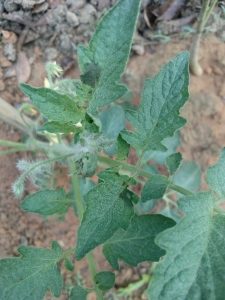Tomato is an important vegetable crop in India, both for domestic consumption and for export. India is the world’s second-largest producer of tomatoes, after China, with a production of over 20.34 million metric tonnes in the year 2022. However, they are vulnerable to various pests that can cause significant crop loss. Among them, red spider mites (Tetranychus spp) are a common pest that infest tomato plants. Nymph and adult stage of the pest affect the crop. Red spider mites can reproduce rapidly, and their populations can quickly grow out of control if left unchecked. Regular monitoring and implementing proper management measures can help to control red spider mites.
How does it spread?
Wind currents, irrigation water and mechanically through field workers or tools are the factors responsible for spread of mites over short distances. Presence of host plants such as beans, citrus cotton, tobacco, brinjal, potato, cotton and weeds can also spread the mite infestation.
Red Mites in Tomato Damage Symptoms:

- The mites feed on the undersides of the leaves, with the help of its piercing and sucking mouth part, thus sucking out the sap and causing the leaves to turn yellow.
- As the infestation progresses, fine webbing can be noticed on under surface of leaves and later the whole leaves. Sometimes, this webbing can cover the entire plant.
- Their feeding pattern can cause ‘stippling’ or tiny white to yellow speckles on the upper leaf surface.
- On severe infestation, leaves become brittle and bronzy i.e., reddish brown appearance.
- Presence of eggs on the under surface of the leaves.
- Affected leaves may dry and drop prematurely.
- Causes stunted growth of plants and affects flower and fruit formation.
Preventive measures:
- Monitor the plants regularly for early signs of infestation, such as yellowing leaves and webbing.
- Avoid dusty conditions in the field by following regular irrigation practices.
- Avoid using contaminated tools and equipments.
- Avoid overcrowding your plants, which can create an environment that is favorable for red spider mite infestations.
- Introduce beneficial insects, such as ladybugs and greenlace wings, that feed on red spider mites.
- Remove and destroy any infected plant material from the field to prevent the spread of mites to other plants.
- Avoid growing tomato crops in close proximity with its alternate hosts.
- Use a high-pressure water spray to knock off mites from your plants and disrupt their life cycle.
- Keep the field clean and free of debris to eliminate hiding places for mites.
- Spray neem oil extracts at 1 –2 ml/lit of water at an interval of 15 days.
Control Measures for Red Spider Mites in Tomato:
| Product name | Technical content | Dosage |
| Biological Management | ||
| Royal Clear Mite | 100% derived from plant extracts | 2 ml/lit water |
| R Mite Bio Acaricide | Plant extracts | 1 – 2 ml/ lit water |
| PerfoMite | Phyto-extracts – 30%, Enzyme extracts – 5%, Chitin Dissolvers | 2 ml / 1 lit water |
| Chemical Management | ||
| Oberon Insecticide | Spiromesifen 22.9% SC | 0.3 ml /lit water |
| Abacin Insecticide | Abamectin 1.9% EC | 0.7 ml /lit water |
| Maiden Insecticide | Hexythiazox 5.45% EC | 1 ml /lit water |
| Intrepid Insecticide | Chlorfenapyr 10% SC | 2 ml/lit water |
| Danitol Insecticide | Fenpropathrin 10% EC | 1.5 ml/lit water |
| Movento Energy | Spirotetramat 11.01% + Imidacloprid 11.01% SC | 0.5 – 1 ml/lit water |
| Omite Insecticide | Propargite 57% EC | 2 ml/lit water |
| Pyromite | Fenpyroximate 5% EC | 1.5 – 3 ml/lit water |
Indigenous Technical Knowledge (ITK) practices you can follow to control Red Spider Mite in tomato:
- Spraying cow urine diluted with water (1:20) on tomato plants can help control red spider mites.
- A mixture of garlic and chilli with water (1:5) can be used to create an insecticide that can control red spider mites.
- Marigold plants are attractive to red spider mites and can be used as a trap crop. Planting marigolds around tomato plants can help control mite populations.
- Coriander acts as repellent to control red spider mite. It can be prepared by boiling 200 gm of crushed coriander seeds in 1 liter of water for 10 min. Then, dilute it with 2 liters of water and spray on the infested plant parts early in the morning.
- Certain plant extracts such as those from ginger, turmeric, and papaya have been found to have insecticidal properties and can be used to control red spider mites in tomatoes.
- Turmeric extract preparation: Soak 20 gm of shredded turmeric rhizome in 200 ml of cow urine. Dilute them with 2 – 3 liters of water and then add 8 – 12 ml of soap. Use this extract for spraying.
- Spraying neem oil extracts.
Learn More About Tomato Farming – Click Here





